Report: Effective Team Working and Communication in Healthcare
VerifiedAdded on 2022/11/25
|10
|2580
|87
Report
AI Summary
This report delves into the crucial aspects of effective team working and communication within health and social care settings. It highlights the positive impacts of teamwork, such as improved morale, reduced conflict, and the fostering of diversity and a creative learning environment. The report emphasizes the importance of the Tuckman model (forming, storming, norming, performing, and adjourning) in developing strong and dedicated teams, providing insights into each stage and the manager's role. Furthermore, the report discusses the significance of Belbin team roles (thought-oriented, action-oriented, and people-oriented) in creating cohesive and effective teams. The conclusion reinforces the necessity of team working in healthcare and the benefits of implementing the models and strategies outlined for successful team development and improved patient outcomes.
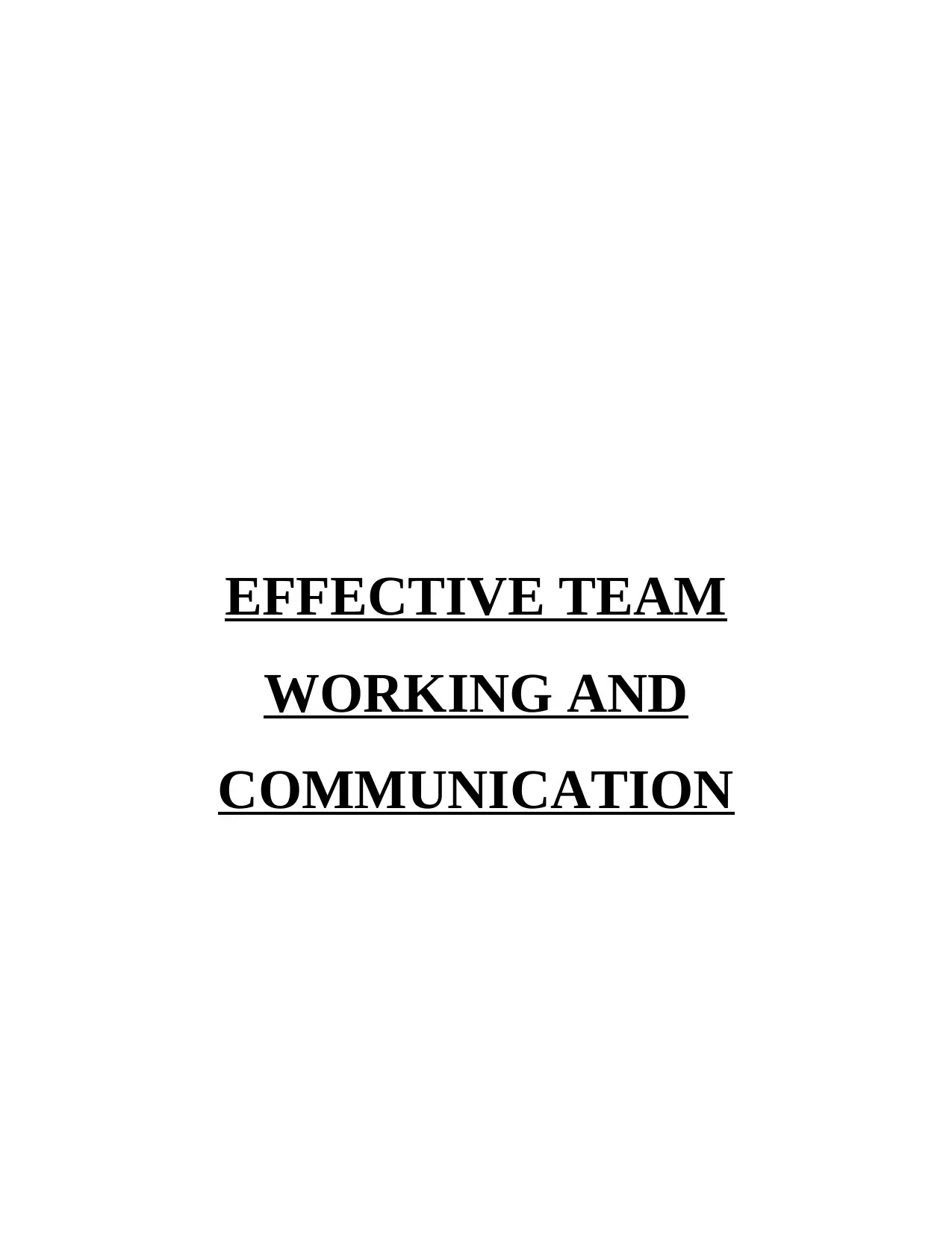
EFFECTIVE TEAM
WORKING AND
COMMUNICATION
WORKING AND
COMMUNICATION
Paraphrase This Document
Need a fresh take? Get an instant paraphrase of this document with our AI Paraphraser
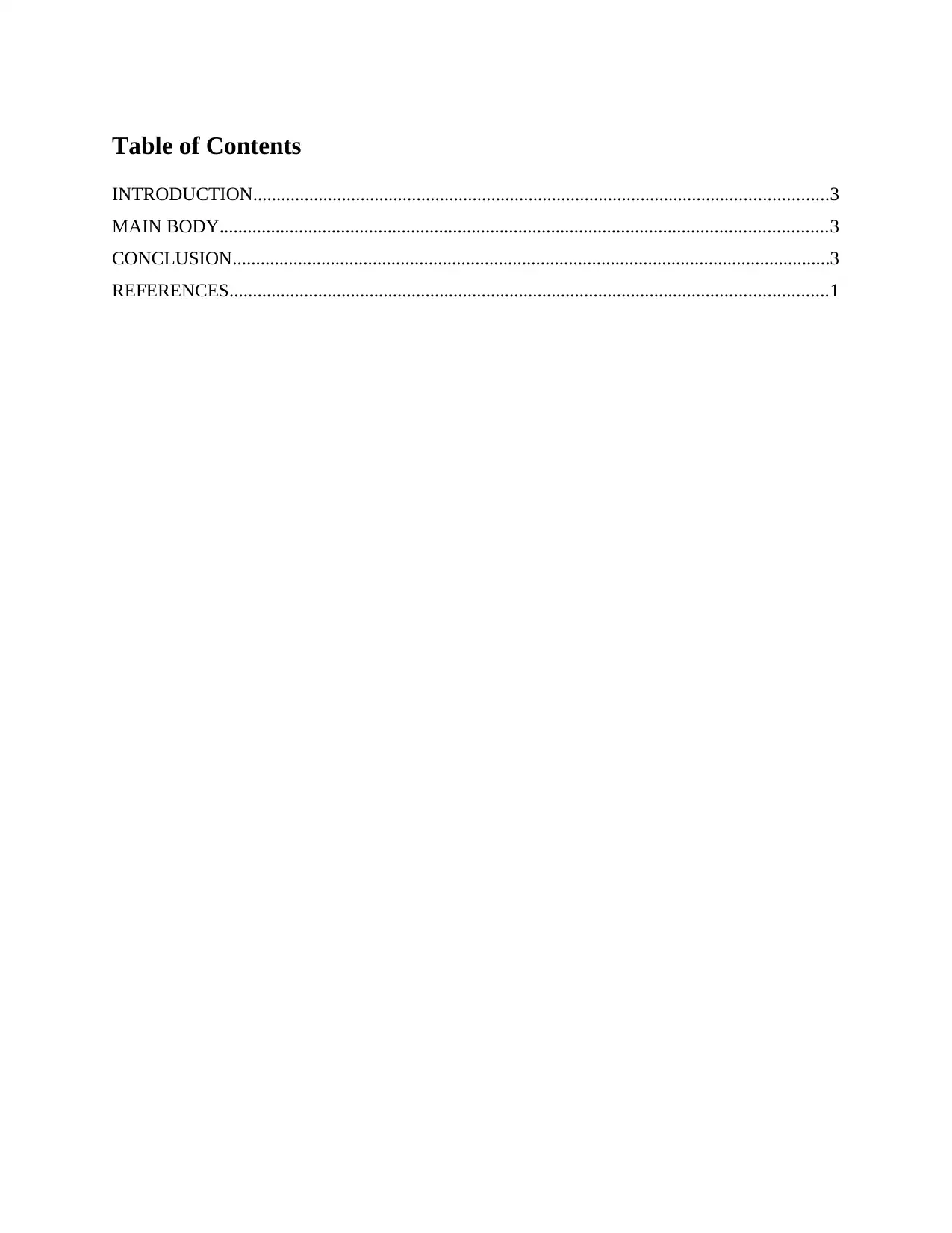
Table of Contents
INTRODUCTION...........................................................................................................................3
MAIN BODY..................................................................................................................................3
CONCLUSION................................................................................................................................3
REFERENCES................................................................................................................................1
INTRODUCTION...........................................................................................................................3
MAIN BODY..................................................................................................................................3
CONCLUSION................................................................................................................................3
REFERENCES................................................................................................................................1
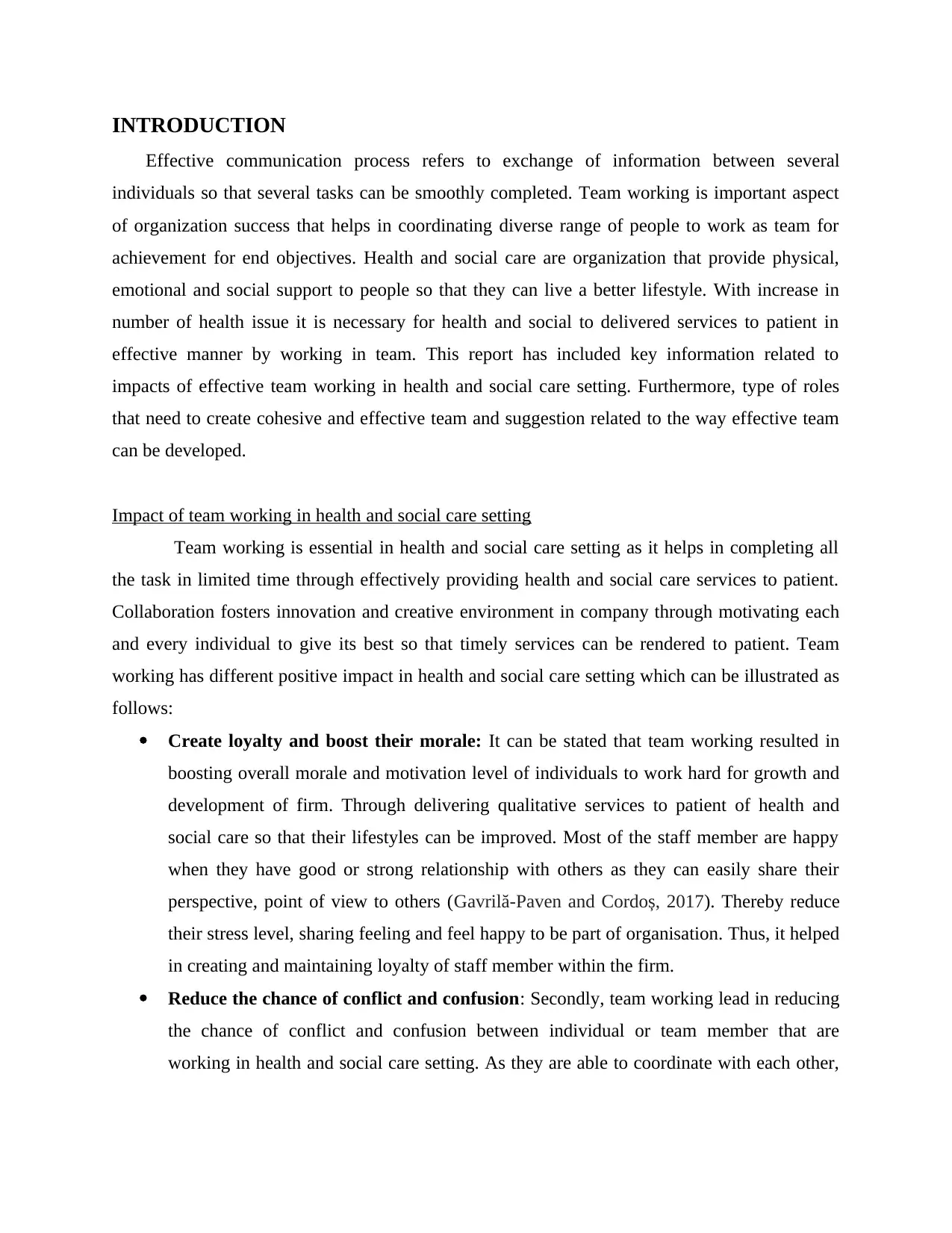
INTRODUCTION
Effective communication process refers to exchange of information between several
individuals so that several tasks can be smoothly completed. Team working is important aspect
of organization success that helps in coordinating diverse range of people to work as team for
achievement for end objectives. Health and social care are organization that provide physical,
emotional and social support to people so that they can live a better lifestyle. With increase in
number of health issue it is necessary for health and social to delivered services to patient in
effective manner by working in team. This report has included key information related to
impacts of effective team working in health and social care setting. Furthermore, type of roles
that need to create cohesive and effective team and suggestion related to the way effective team
can be developed.
Impact of team working in health and social care setting
Team working is essential in health and social care setting as it helps in completing all
the task in limited time through effectively providing health and social care services to patient.
Collaboration fosters innovation and creative environment in company through motivating each
and every individual to give its best so that timely services can be rendered to patient. Team
working has different positive impact in health and social care setting which can be illustrated as
follows:
Create loyalty and boost their morale: It can be stated that team working resulted in
boosting overall morale and motivation level of individuals to work hard for growth and
development of firm. Through delivering qualitative services to patient of health and
social care so that their lifestyles can be improved. Most of the staff member are happy
when they have good or strong relationship with others as they can easily share their
perspective, point of view to others (Gavrilă-Paven and Cordoș, 2017). Thereby reduce
their stress level, sharing feeling and feel happy to be part of organisation. Thus, it helped
in creating and maintaining loyalty of staff member within the firm.
Reduce the chance of conflict and confusion: Secondly, team working lead in reducing
the chance of conflict and confusion between individual or team member that are
working in health and social care setting. As they are able to coordinate with each other,
Effective communication process refers to exchange of information between several
individuals so that several tasks can be smoothly completed. Team working is important aspect
of organization success that helps in coordinating diverse range of people to work as team for
achievement for end objectives. Health and social care are organization that provide physical,
emotional and social support to people so that they can live a better lifestyle. With increase in
number of health issue it is necessary for health and social to delivered services to patient in
effective manner by working in team. This report has included key information related to
impacts of effective team working in health and social care setting. Furthermore, type of roles
that need to create cohesive and effective team and suggestion related to the way effective team
can be developed.
Impact of team working in health and social care setting
Team working is essential in health and social care setting as it helps in completing all
the task in limited time through effectively providing health and social care services to patient.
Collaboration fosters innovation and creative environment in company through motivating each
and every individual to give its best so that timely services can be rendered to patient. Team
working has different positive impact in health and social care setting which can be illustrated as
follows:
Create loyalty and boost their morale: It can be stated that team working resulted in
boosting overall morale and motivation level of individuals to work hard for growth and
development of firm. Through delivering qualitative services to patient of health and
social care so that their lifestyles can be improved. Most of the staff member are happy
when they have good or strong relationship with others as they can easily share their
perspective, point of view to others (Gavrilă-Paven and Cordoș, 2017). Thereby reduce
their stress level, sharing feeling and feel happy to be part of organisation. Thus, it helped
in creating and maintaining loyalty of staff member within the firm.
Reduce the chance of conflict and confusion: Secondly, team working lead in reducing
the chance of conflict and confusion between individual or team member that are
working in health and social care setting. As they are able to coordinate with each other,
⊘ This is a preview!⊘
Do you want full access?
Subscribe today to unlock all pages.

Trusted by 1+ million students worldwide
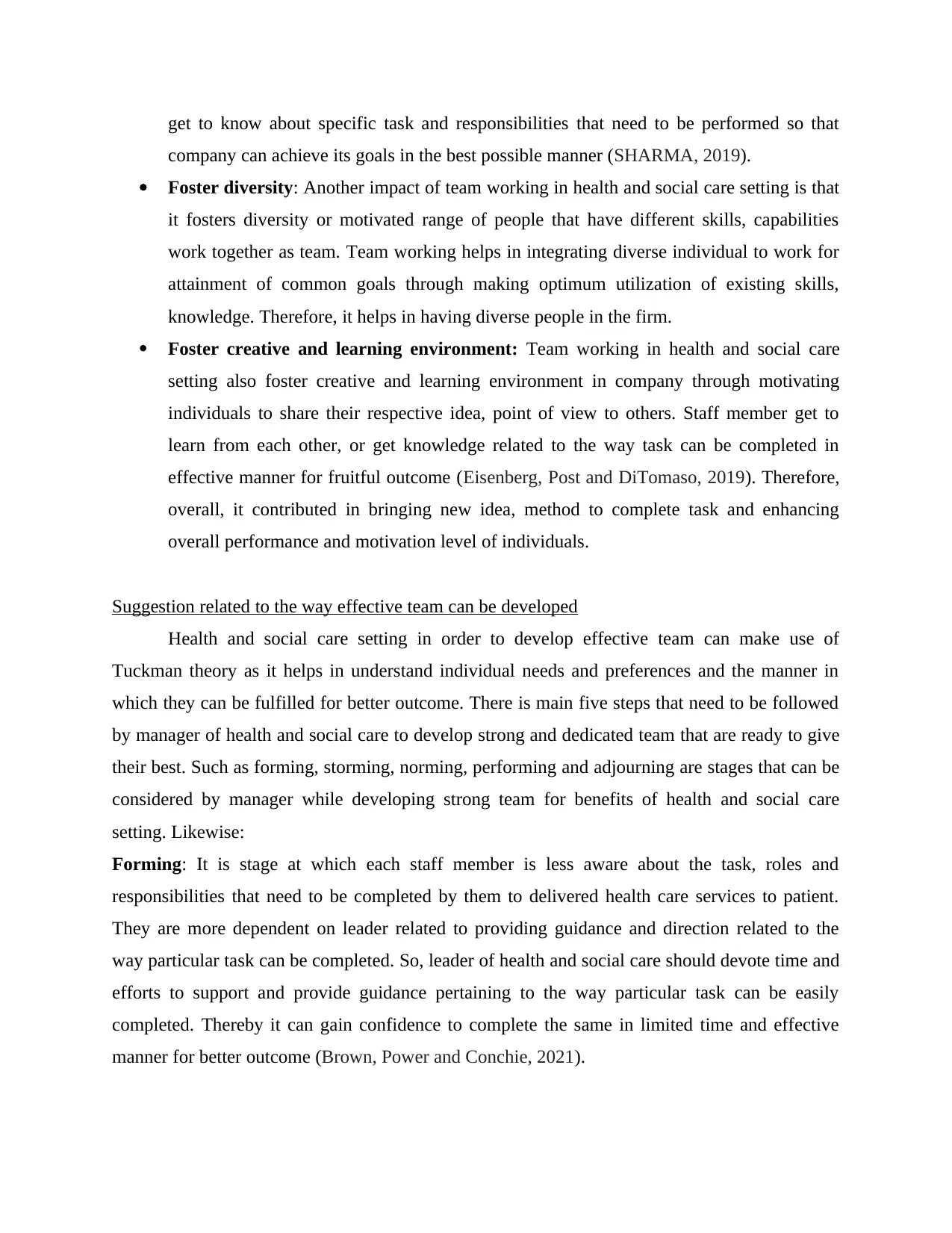
get to know about specific task and responsibilities that need to be performed so that
company can achieve its goals in the best possible manner (SHARMA, 2019).
Foster diversity: Another impact of team working in health and social care setting is that
it fosters diversity or motivated range of people that have different skills, capabilities
work together as team. Team working helps in integrating diverse individual to work for
attainment of common goals through making optimum utilization of existing skills,
knowledge. Therefore, it helps in having diverse people in the firm.
Foster creative and learning environment: Team working in health and social care
setting also foster creative and learning environment in company through motivating
individuals to share their respective idea, point of view to others. Staff member get to
learn from each other, or get knowledge related to the way task can be completed in
effective manner for fruitful outcome (Eisenberg, Post and DiTomaso, 2019). Therefore,
overall, it contributed in bringing new idea, method to complete task and enhancing
overall performance and motivation level of individuals.
Suggestion related to the way effective team can be developed
Health and social care setting in order to develop effective team can make use of
Tuckman theory as it helps in understand individual needs and preferences and the manner in
which they can be fulfilled for better outcome. There is main five steps that need to be followed
by manager of health and social care to develop strong and dedicated team that are ready to give
their best. Such as forming, storming, norming, performing and adjourning are stages that can be
considered by manager while developing strong team for benefits of health and social care
setting. Likewise:
Forming: It is stage at which each staff member is less aware about the task, roles and
responsibilities that need to be completed by them to delivered health care services to patient.
They are more dependent on leader related to providing guidance and direction related to the
way particular task can be completed. So, leader of health and social care should devote time and
efforts to support and provide guidance pertaining to the way particular task can be easily
completed. Thereby it can gain confidence to complete the same in limited time and effective
manner for better outcome (Brown, Power and Conchie, 2021).
company can achieve its goals in the best possible manner (SHARMA, 2019).
Foster diversity: Another impact of team working in health and social care setting is that
it fosters diversity or motivated range of people that have different skills, capabilities
work together as team. Team working helps in integrating diverse individual to work for
attainment of common goals through making optimum utilization of existing skills,
knowledge. Therefore, it helps in having diverse people in the firm.
Foster creative and learning environment: Team working in health and social care
setting also foster creative and learning environment in company through motivating
individuals to share their respective idea, point of view to others. Staff member get to
learn from each other, or get knowledge related to the way task can be completed in
effective manner for fruitful outcome (Eisenberg, Post and DiTomaso, 2019). Therefore,
overall, it contributed in bringing new idea, method to complete task and enhancing
overall performance and motivation level of individuals.
Suggestion related to the way effective team can be developed
Health and social care setting in order to develop effective team can make use of
Tuckman theory as it helps in understand individual needs and preferences and the manner in
which they can be fulfilled for better outcome. There is main five steps that need to be followed
by manager of health and social care to develop strong and dedicated team that are ready to give
their best. Such as forming, storming, norming, performing and adjourning are stages that can be
considered by manager while developing strong team for benefits of health and social care
setting. Likewise:
Forming: It is stage at which each staff member is less aware about the task, roles and
responsibilities that need to be completed by them to delivered health care services to patient.
They are more dependent on leader related to providing guidance and direction related to the
way particular task can be completed. So, leader of health and social care should devote time and
efforts to support and provide guidance pertaining to the way particular task can be easily
completed. Thereby it can gain confidence to complete the same in limited time and effective
manner for better outcome (Brown, Power and Conchie, 2021).
Paraphrase This Document
Need a fresh take? Get an instant paraphrase of this document with our AI Paraphraser
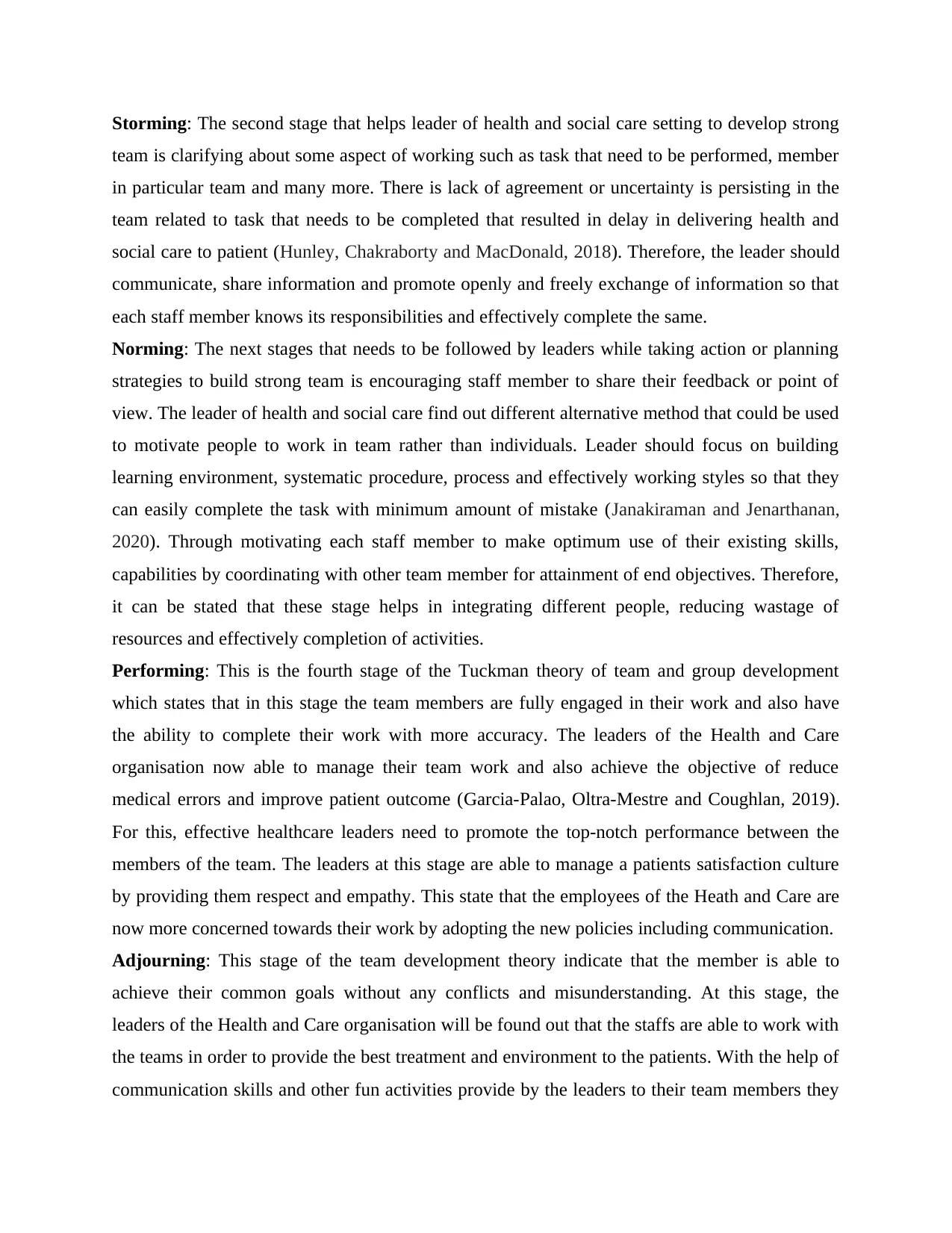
Storming: The second stage that helps leader of health and social care setting to develop strong
team is clarifying about some aspect of working such as task that need to be performed, member
in particular team and many more. There is lack of agreement or uncertainty is persisting in the
team related to task that needs to be completed that resulted in delay in delivering health and
social care to patient (Hunley, Chakraborty and MacDonald, 2018). Therefore, the leader should
communicate, share information and promote openly and freely exchange of information so that
each staff member knows its responsibilities and effectively complete the same.
Norming: The next stages that needs to be followed by leaders while taking action or planning
strategies to build strong team is encouraging staff member to share their feedback or point of
view. The leader of health and social care find out different alternative method that could be used
to motivate people to work in team rather than individuals. Leader should focus on building
learning environment, systematic procedure, process and effectively working styles so that they
can easily complete the task with minimum amount of mistake (Janakiraman and Jenarthanan,
2020). Through motivating each staff member to make optimum use of their existing skills,
capabilities by coordinating with other team member for attainment of end objectives. Therefore,
it can be stated that these stage helps in integrating different people, reducing wastage of
resources and effectively completion of activities.
Performing: This is the fourth stage of the Tuckman theory of team and group development
which states that in this stage the team members are fully engaged in their work and also have
the ability to complete their work with more accuracy. The leaders of the Health and Care
organisation now able to manage their team work and also achieve the objective of reduce
medical errors and improve patient outcome (Garcia-Palao, Oltra-Mestre and Coughlan, 2019).
For this, effective healthcare leaders need to promote the top-notch performance between the
members of the team. The leaders at this stage are able to manage a patients satisfaction culture
by providing them respect and empathy. This state that the employees of the Heath and Care are
now more concerned towards their work by adopting the new policies including communication.
Adjourning: This stage of the team development theory indicate that the member is able to
achieve their common goals without any conflicts and misunderstanding. At this stage, the
leaders of the Health and Care organisation will be found out that the staffs are able to work with
the teams in order to provide the best treatment and environment to the patients. With the help of
communication skills and other fun activities provide by the leaders to their team members they
team is clarifying about some aspect of working such as task that need to be performed, member
in particular team and many more. There is lack of agreement or uncertainty is persisting in the
team related to task that needs to be completed that resulted in delay in delivering health and
social care to patient (Hunley, Chakraborty and MacDonald, 2018). Therefore, the leader should
communicate, share information and promote openly and freely exchange of information so that
each staff member knows its responsibilities and effectively complete the same.
Norming: The next stages that needs to be followed by leaders while taking action or planning
strategies to build strong team is encouraging staff member to share their feedback or point of
view. The leader of health and social care find out different alternative method that could be used
to motivate people to work in team rather than individuals. Leader should focus on building
learning environment, systematic procedure, process and effectively working styles so that they
can easily complete the task with minimum amount of mistake (Janakiraman and Jenarthanan,
2020). Through motivating each staff member to make optimum use of their existing skills,
capabilities by coordinating with other team member for attainment of end objectives. Therefore,
it can be stated that these stage helps in integrating different people, reducing wastage of
resources and effectively completion of activities.
Performing: This is the fourth stage of the Tuckman theory of team and group development
which states that in this stage the team members are fully engaged in their work and also have
the ability to complete their work with more accuracy. The leaders of the Health and Care
organisation now able to manage their team work and also achieve the objective of reduce
medical errors and improve patient outcome (Garcia-Palao, Oltra-Mestre and Coughlan, 2019).
For this, effective healthcare leaders need to promote the top-notch performance between the
members of the team. The leaders at this stage are able to manage a patients satisfaction culture
by providing them respect and empathy. This state that the employees of the Heath and Care are
now more concerned towards their work by adopting the new policies including communication.
Adjourning: This stage of the team development theory indicate that the member is able to
achieve their common goals without any conflicts and misunderstanding. At this stage, the
leaders of the Health and Care organisation will be found out that the staffs are able to work with
the teams in order to provide the best treatment and environment to the patients. With the help of
communication skills and other fun activities provide by the leaders to their team members they
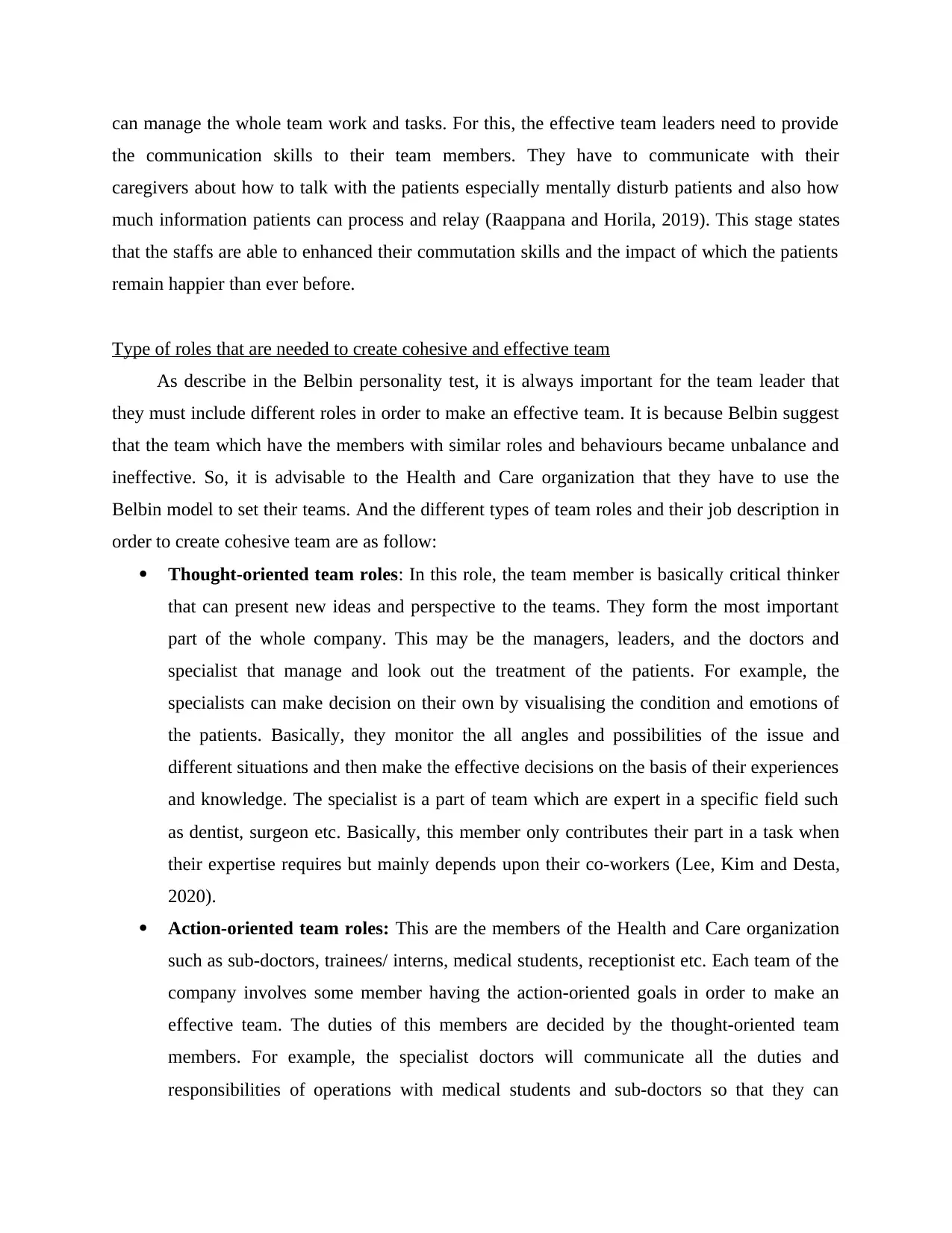
can manage the whole team work and tasks. For this, the effective team leaders need to provide
the communication skills to their team members. They have to communicate with their
caregivers about how to talk with the patients especially mentally disturb patients and also how
much information patients can process and relay (Raappana and Horila, 2019). This stage states
that the staffs are able to enhanced their commutation skills and the impact of which the patients
remain happier than ever before.
Type of roles that are needed to create cohesive and effective team
As describe in the Belbin personality test, it is always important for the team leader that
they must include different roles in order to make an effective team. It is because Belbin suggest
that the team which have the members with similar roles and behaviours became unbalance and
ineffective. So, it is advisable to the Health and Care organization that they have to use the
Belbin model to set their teams. And the different types of team roles and their job description in
order to create cohesive team are as follow:
Thought-oriented team roles: In this role, the team member is basically critical thinker
that can present new ideas and perspective to the teams. They form the most important
part of the whole company. This may be the managers, leaders, and the doctors and
specialist that manage and look out the treatment of the patients. For example, the
specialists can make decision on their own by visualising the condition and emotions of
the patients. Basically, they monitor the all angles and possibilities of the issue and
different situations and then make the effective decisions on the basis of their experiences
and knowledge. The specialist is a part of team which are expert in a specific field such
as dentist, surgeon etc. Basically, this member only contributes their part in a task when
their expertise requires but mainly depends upon their co-workers (Lee, Kim and Desta,
2020).
Action-oriented team roles: This are the members of the Health and Care organization
such as sub-doctors, trainees/ interns, medical students, receptionist etc. Each team of the
company involves some member having the action-oriented goals in order to make an
effective team. The duties of this members are decided by the thought-oriented team
members. For example, the specialist doctors will communicate all the duties and
responsibilities of operations with medical students and sub-doctors so that they can
the communication skills to their team members. They have to communicate with their
caregivers about how to talk with the patients especially mentally disturb patients and also how
much information patients can process and relay (Raappana and Horila, 2019). This stage states
that the staffs are able to enhanced their commutation skills and the impact of which the patients
remain happier than ever before.
Type of roles that are needed to create cohesive and effective team
As describe in the Belbin personality test, it is always important for the team leader that
they must include different roles in order to make an effective team. It is because Belbin suggest
that the team which have the members with similar roles and behaviours became unbalance and
ineffective. So, it is advisable to the Health and Care organization that they have to use the
Belbin model to set their teams. And the different types of team roles and their job description in
order to create cohesive team are as follow:
Thought-oriented team roles: In this role, the team member is basically critical thinker
that can present new ideas and perspective to the teams. They form the most important
part of the whole company. This may be the managers, leaders, and the doctors and
specialist that manage and look out the treatment of the patients. For example, the
specialists can make decision on their own by visualising the condition and emotions of
the patients. Basically, they monitor the all angles and possibilities of the issue and
different situations and then make the effective decisions on the basis of their experiences
and knowledge. The specialist is a part of team which are expert in a specific field such
as dentist, surgeon etc. Basically, this member only contributes their part in a task when
their expertise requires but mainly depends upon their co-workers (Lee, Kim and Desta,
2020).
Action-oriented team roles: This are the members of the Health and Care organization
such as sub-doctors, trainees/ interns, medical students, receptionist etc. Each team of the
company involves some member having the action-oriented goals in order to make an
effective team. The duties of this members are decided by the thought-oriented team
members. For example, the specialist doctors will communicate all the duties and
responsibilities of operations with medical students and sub-doctors so that they can
⊘ This is a preview!⊘
Do you want full access?
Subscribe today to unlock all pages.

Trusted by 1+ million students worldwide
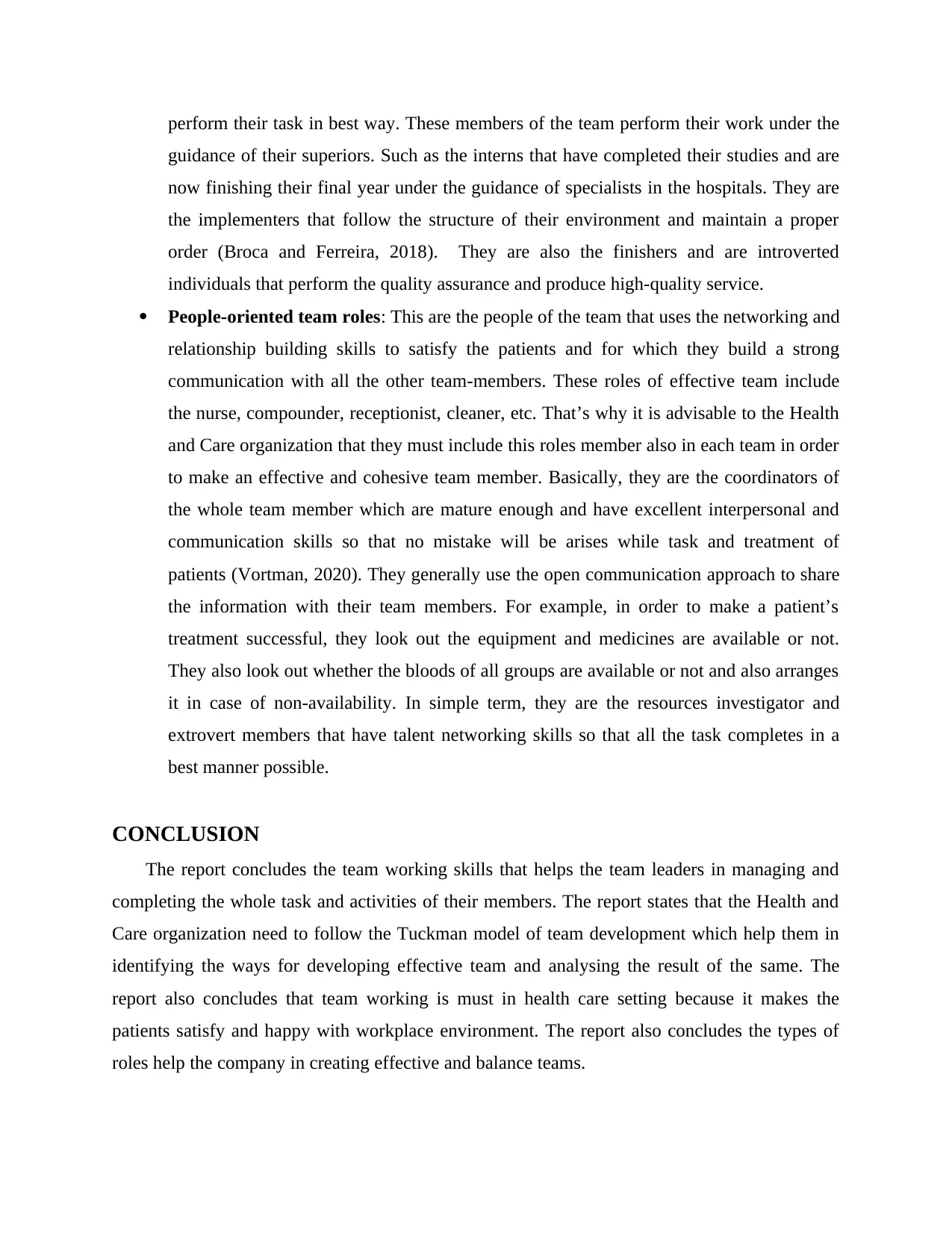
perform their task in best way. These members of the team perform their work under the
guidance of their superiors. Such as the interns that have completed their studies and are
now finishing their final year under the guidance of specialists in the hospitals. They are
the implementers that follow the structure of their environment and maintain a proper
order (Broca and Ferreira, 2018). They are also the finishers and are introverted
individuals that perform the quality assurance and produce high-quality service.
People-oriented team roles: This are the people of the team that uses the networking and
relationship building skills to satisfy the patients and for which they build a strong
communication with all the other team-members. These roles of effective team include
the nurse, compounder, receptionist, cleaner, etc. That’s why it is advisable to the Health
and Care organization that they must include this roles member also in each team in order
to make an effective and cohesive team member. Basically, they are the coordinators of
the whole team member which are mature enough and have excellent interpersonal and
communication skills so that no mistake will be arises while task and treatment of
patients (Vortman, 2020). They generally use the open communication approach to share
the information with their team members. For example, in order to make a patient’s
treatment successful, they look out the equipment and medicines are available or not.
They also look out whether the bloods of all groups are available or not and also arranges
it in case of non-availability. In simple term, they are the resources investigator and
extrovert members that have talent networking skills so that all the task completes in a
best manner possible.
CONCLUSION
The report concludes the team working skills that helps the team leaders in managing and
completing the whole task and activities of their members. The report states that the Health and
Care organization need to follow the Tuckman model of team development which help them in
identifying the ways for developing effective team and analysing the result of the same. The
report also concludes that team working is must in health care setting because it makes the
patients satisfy and happy with workplace environment. The report also concludes the types of
roles help the company in creating effective and balance teams.
guidance of their superiors. Such as the interns that have completed their studies and are
now finishing their final year under the guidance of specialists in the hospitals. They are
the implementers that follow the structure of their environment and maintain a proper
order (Broca and Ferreira, 2018). They are also the finishers and are introverted
individuals that perform the quality assurance and produce high-quality service.
People-oriented team roles: This are the people of the team that uses the networking and
relationship building skills to satisfy the patients and for which they build a strong
communication with all the other team-members. These roles of effective team include
the nurse, compounder, receptionist, cleaner, etc. That’s why it is advisable to the Health
and Care organization that they must include this roles member also in each team in order
to make an effective and cohesive team member. Basically, they are the coordinators of
the whole team member which are mature enough and have excellent interpersonal and
communication skills so that no mistake will be arises while task and treatment of
patients (Vortman, 2020). They generally use the open communication approach to share
the information with their team members. For example, in order to make a patient’s
treatment successful, they look out the equipment and medicines are available or not.
They also look out whether the bloods of all groups are available or not and also arranges
it in case of non-availability. In simple term, they are the resources investigator and
extrovert members that have talent networking skills so that all the task completes in a
best manner possible.
CONCLUSION
The report concludes the team working skills that helps the team leaders in managing and
completing the whole task and activities of their members. The report states that the Health and
Care organization need to follow the Tuckman model of team development which help them in
identifying the ways for developing effective team and analysing the result of the same. The
report also concludes that team working is must in health care setting because it makes the
patients satisfy and happy with workplace environment. The report also concludes the types of
roles help the company in creating effective and balance teams.
Paraphrase This Document
Need a fresh take? Get an instant paraphrase of this document with our AI Paraphraser

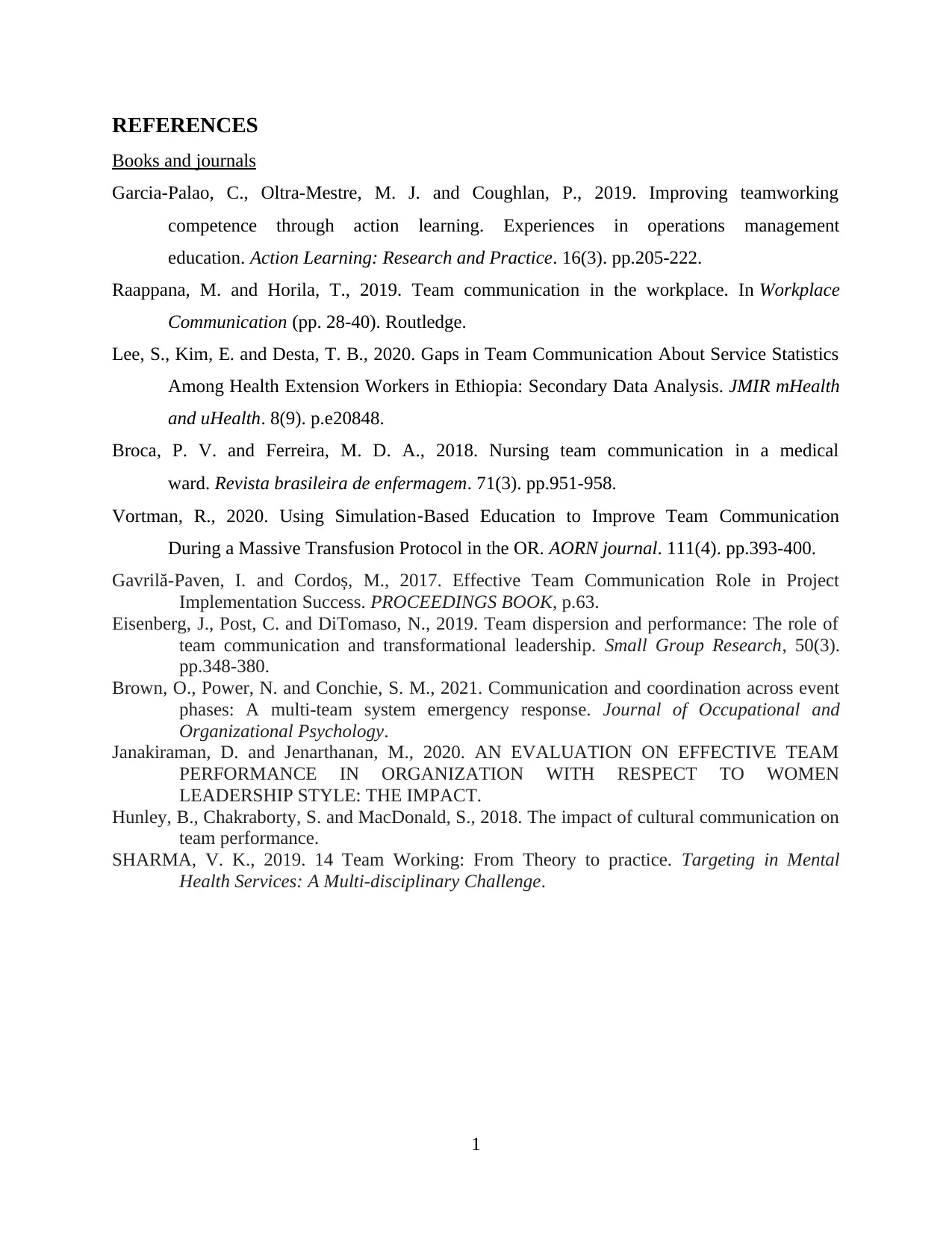
REFERENCES
Books and journals
Garcia-Palao, C., Oltra-Mestre, M. J. and Coughlan, P., 2019. Improving teamworking
competence through action learning. Experiences in operations management
education. Action Learning: Research and Practice. 16(3). pp.205-222.
Raappana, M. and Horila, T., 2019. Team communication in the workplace. In Workplace
Communication (pp. 28-40). Routledge.
Lee, S., Kim, E. and Desta, T. B., 2020. Gaps in Team Communication About Service Statistics
Among Health Extension Workers in Ethiopia: Secondary Data Analysis. JMIR mHealth
and uHealth. 8(9). p.e20848.
Broca, P. V. and Ferreira, M. D. A., 2018. Nursing team communication in a medical
ward. Revista brasileira de enfermagem. 71(3). pp.951-958.
Vortman, R., 2020. Using Simulation‐Based Education to Improve Team Communication
During a Massive Transfusion Protocol in the OR. AORN journal. 111(4). pp.393-400.
Gavrilă-Paven, I. and Cordoș, M., 2017. Effective Team Communication Role in Project
Implementation Success. PROCEEDINGS BOOK, p.63.
Eisenberg, J., Post, C. and DiTomaso, N., 2019. Team dispersion and performance: The role of
team communication and transformational leadership. Small Group Research, 50(3).
pp.348-380.
Brown, O., Power, N. and Conchie, S. M., 2021. Communication and coordination across event
phases: A multi‐team system emergency response. Journal of Occupational and
Organizational Psychology.
Janakiraman, D. and Jenarthanan, M., 2020. AN EVALUATION ON EFFECTIVE TEAM
PERFORMANCE IN ORGANIZATION WITH RESPECT TO WOMEN
LEADERSHIP STYLE: THE IMPACT.
Hunley, B., Chakraborty, S. and MacDonald, S., 2018. The impact of cultural communication on
team performance.
SHARMA, V. K., 2019. 14 Team Working: From Theory to practice. Targeting in Mental
Health Services: A Multi-disciplinary Challenge.
1
Books and journals
Garcia-Palao, C., Oltra-Mestre, M. J. and Coughlan, P., 2019. Improving teamworking
competence through action learning. Experiences in operations management
education. Action Learning: Research and Practice. 16(3). pp.205-222.
Raappana, M. and Horila, T., 2019. Team communication in the workplace. In Workplace
Communication (pp. 28-40). Routledge.
Lee, S., Kim, E. and Desta, T. B., 2020. Gaps in Team Communication About Service Statistics
Among Health Extension Workers in Ethiopia: Secondary Data Analysis. JMIR mHealth
and uHealth. 8(9). p.e20848.
Broca, P. V. and Ferreira, M. D. A., 2018. Nursing team communication in a medical
ward. Revista brasileira de enfermagem. 71(3). pp.951-958.
Vortman, R., 2020. Using Simulation‐Based Education to Improve Team Communication
During a Massive Transfusion Protocol in the OR. AORN journal. 111(4). pp.393-400.
Gavrilă-Paven, I. and Cordoș, M., 2017. Effective Team Communication Role in Project
Implementation Success. PROCEEDINGS BOOK, p.63.
Eisenberg, J., Post, C. and DiTomaso, N., 2019. Team dispersion and performance: The role of
team communication and transformational leadership. Small Group Research, 50(3).
pp.348-380.
Brown, O., Power, N. and Conchie, S. M., 2021. Communication and coordination across event
phases: A multi‐team system emergency response. Journal of Occupational and
Organizational Psychology.
Janakiraman, D. and Jenarthanan, M., 2020. AN EVALUATION ON EFFECTIVE TEAM
PERFORMANCE IN ORGANIZATION WITH RESPECT TO WOMEN
LEADERSHIP STYLE: THE IMPACT.
Hunley, B., Chakraborty, S. and MacDonald, S., 2018. The impact of cultural communication on
team performance.
SHARMA, V. K., 2019. 14 Team Working: From Theory to practice. Targeting in Mental
Health Services: A Multi-disciplinary Challenge.
1
⊘ This is a preview!⊘
Do you want full access?
Subscribe today to unlock all pages.

Trusted by 1+ million students worldwide

2
1 out of 10
Related Documents
Your All-in-One AI-Powered Toolkit for Academic Success.
+13062052269
info@desklib.com
Available 24*7 on WhatsApp / Email
![[object Object]](/_next/static/media/star-bottom.7253800d.svg)
Unlock your academic potential
Copyright © 2020–2025 A2Z Services. All Rights Reserved. Developed and managed by ZUCOL.





